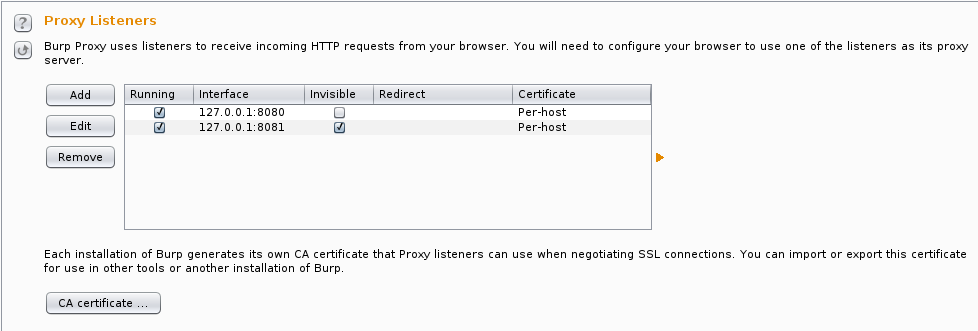I wanted to take a look at all HTTP(S) traffic coming from an Android device, even if applications made direct connections without a proxy, so I set up a transparent Burp proxy. I decided to put the Proxy on my Kali VM on my laptop, but didn’t want to run an AP on there, so I needed to get the traffic to there.
Network Setup

The diagram shows that my wireless lab is on a separate subnet from the rest of my network, including my laptop. The lab network is a NAT run by IPTables on the Virtual Router. While I certainly could’ve ARP poisoned the connection between the Internet Router and the Virtual Router, or even added a static route, I wanted a cleaner solution that would be easier to enable/disable.
Setting up the Redirect
I decided to use IPTables on the virtual router to redirect the traffic to my Kali Laptop. Furthermore, I decided to enable/disable the redirect based on logging in/out via SSH, but I needed to make sure the redirect would get torn down even if there’s not a clean logout: i.e., the VM crashes, the SSH connection gets interrupted, etc. Enter pam_exec. By using the pam_exec module, we can have an arbitrary command run on log in/out, which can setup and reset the IPTables REDIRECT via an SSH tunnel to my Burp Proxy.
In order to get the command executed on any login/logout, I added the following line to /etc/pam.d/common-session:
1
session optional pam_exec.so log=/var/log/burp.log /opt/burp.sh
This launches the following script, that checks if its being invoked for the right user, for SSH sessions, and then inserts or deletes the relevant IPTables rules.
1
2
3
4
5
6
7
8
9
10
11
12
13
14
15
16
17
18
19
20
21
22
23
24
25
26
27
28
29
30
31
32
#!/bin/bash
BURP_PORT=8080
BURP_USER=tap
LAN_IF=eth1
set -o nounset
function ipt_command {
ACTION=$1
echo iptables -t nat $ACTION PREROUTING -i $LAN_IF -p tcp -m multiport --dports 80,443 -j REDIRECT --to-ports $BURP_PORT\;
echo iptables $ACTION INPUT -i $LAN_IF -p tcp --dport $BURP_PORT -j ACCEPT\;
}
if [ $PAM_USER != $BURP_USER ] ; then
exit 0
fi
if [ $PAM_TTY != "ssh" ] ; then
exit 0
fi
if [ $PAM_TYPE == "open_session" ] ; then
CMD=`ipt_command -I`
elif [ $PAM_TYPE == "close_session" ] ; then
CMD=`ipt_command -D`
fi
date
echo $CMD
eval $CMD
This redirects all traffic incoming from $LAN_IF destined for ports 80 and 443 to local port 8080. This does have the downside of missing traffic on other ports, but this will get nearly all HTTP(S) traffic.
Of course, since the IPTables REDIRECT target still maintains the same interface as the original incoming connection, we need to allow our SSH Port Forward to bind to all interfaces. Add this line to /etc/ssh/sshd_config and restart SSH:
1
GatewayPorts clientspecified
Setting up Burp and SSH
Burp’s setup is pretty straightforward, but since we’re not configuring a proxy in our client application, we’ll need to use invisible proxying mode. I actually put invisible proxying on a separate port (8081) so I have 8080 setup as a regular proxy. I also use the per-host certificate setting to get the “best” SSL experience.

It turns out that there’s an issue with OpenJDK 6 and SSL certificates. Apparently it will advertise algorithms not actually available, and then libnss will throw an exception, causing the connection to fail, and the client will retry with SSLv3 without SNI, preventing Burp from creating proper certificates. It can be worked around by disabling NSS in Java. In /etc/java-6-openjdk/security/java.security, comment out the line with security.provider.9=sun.security.pkcs11.SunPKCS11 ${java.home}/lib/security/nss.cfg.
Forwarding the port over to the wifilab server is pretty straightforward. You can either use the -R command-line option, or better, set things up in ~/.ssh/config.
1
2
3
4
Host wifitap
User tap
Hostname wifilab
RemoteForward *:8080 localhost:8081
This logs in as user tap on host wifilab, forwarding local port 8081 to port 8080 on the wifilab machine. The * for a hostname is to ensure it binds to all interfaces (0.0.0.0), not just localhost.
Setting up Android
At this point, you should have a good setup for intercepting traffic from any client of the WiFi lab, but since I started off wanting to intercept Android traffic, let’s optimize for that by installing our certificate. You can install it as a user certificate, but I’d rather do it as a system cert, and my testing tablet is already rooted, so it’s easy enough.
You’ll want to start by exporting the certificate from Burp and saving it to a file, say burp.der.
Android’s system certificate store is in /system/etc/security/cacerts, and expects OpenSSL-hashed naming, like a0b1c2d3.0 for the certificate names. Another complication is that it’s looking for PEM-formatted certificates, and the export from Burp is DER-formatted. We’ll fix all that up in one chain of OpenSSL commands:
1
2
3
(openssl x509 -inform DER -outform PEM -in burp.der;
openssl x509 -inform DER -in burp.der -text -fingerprint -noout
) > /tmp/`openssl x509 -inform DER -in burp.der -subject_hash -noout`.0
Android before ICS (4.0) uses OpenSSL versions below 1.0.0, so you’ll need to use -subject_hash_old if you’re using an older version of Android. Installing is a pretty simple task (replace HASH.0 with the filename produced by the command above):
1
2
3
4
5
6
7
$ adb push HASH.0 /tmp/HASH.0
$ adb shell
android$ su
android# mount -o remount,rw /system
android# cp /tmp/HASH.0 /system/etc/security/cacerts/
android# chmod 644 /system/etc/security/cacerts/HASH.0
android# reboot
Connect your Android device to your WiFi lab, ssh wifitap from your Kali install running Burp, and you should see your HTTP(S) traffic in Burp (excepting apps that use pinned certificates, that’s another matter entirely). You can check your installed certificate from the Android Security Settings.
Good luck with your Android auditing!